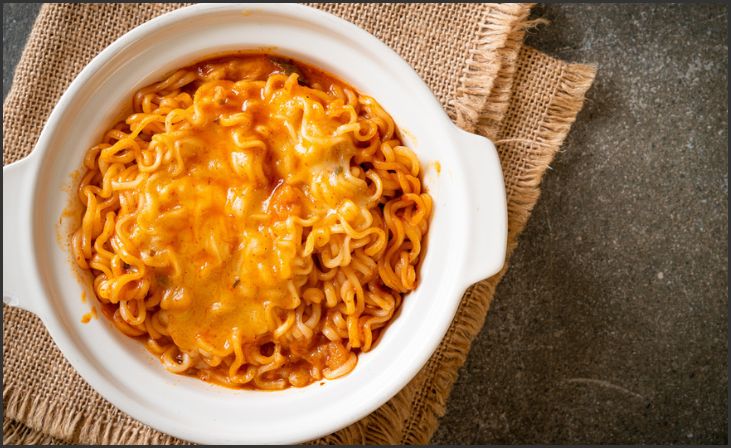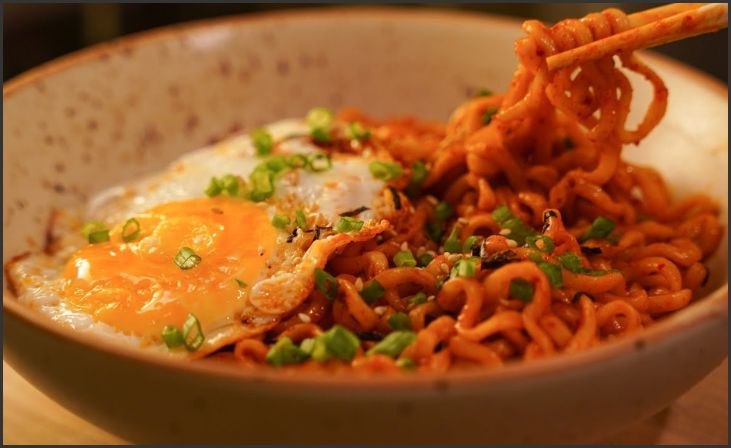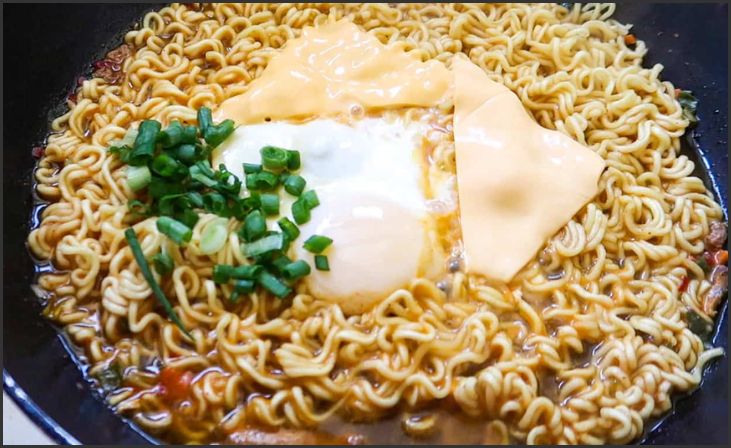We are continually fed weird food combinations via the internet in this modern era. Some are acceptable, even delicious, while others make us feel as though they should be illegal. While this cheesy noodle mixture may seem like the latter, there is no reason to panic – especially if you enjoy both main ingredients.
Whether the answer is ‘yes’ or ‘no,’ there is no better way to determine than to give it a try. This article will educate you on all there is to know about this ‘abnormal’ combination and how to make the ideal bowl of hot spicy cheese ramen at home.
So, if you like Korean ramen noodles, this article is for you since it will teach you how to prepare Korean instant noodles and what is ramen’s Korean flavor? Korean ramen recipes, among others.
Korean Spicy Cheese Ramen


Ramen with cheese is a traditional Korean comfort meal. As the name implies, it is essentially Korean instant noodles with a cheese mixture. Apart from that, milk is occasionally substituted for the typical cup of hot water in the soup.
When American soldiers arrived in Korea during the war, they delivered non-perishable food, including cheese. When the American soldiers departed, the dairy product remained and developed into a significant component of Korean cuisine. As a result, South Korea has grown into one of the top ten importers of US dairy products today.
This cheesy element eventually made its way into Korean culinary history, resulting in new menu items. Finally, adding cheese became an elegant way to enjoy a bowl of instant noodles, resulting in Korean hot cheese ramen.
Popularity
In Korea, instant noodles are pretty popular. Indeed, it has become a national staple. Korea has offered a plethora of noodle cuisines, from quick kimchi ramen to kewpie mayo ramen.
Despite its reputation as a Korean delicacy, cheese ramen is enjoyed by many people worldwide. Given its affordability, delectability, and ease of preparation?
This cheesy meal recently regained global appeal after being popularized on TikTok as lockdown comfort food. After trying, many were first shocked by the combo but eventually fell in love with it. Now, many people who are confined to their homes find solace in this fast supper.
Why Does Korean Ramen Include Cheese?

Korean cuisine, particularly fast noodles, is frequently spicy. As a result, cheese is commonly added to their meals to make them milder. Adding this rich dairy item to dishes like ramen thickens, creamifies, and enhances the broth’s flavor.
South Korea is virtually a cheese paradise lovers since there are hundreds of Korean recipes that include this dairy element! Some of the most well-known include the cheesy Dakgalbi, Buldak, and fried rice.
Some well-known brands have also released a variant of these cheesy instant noodles. Among the most popular are Maruchan and Ottogi cheese ramen.
Do you recall the Samyang Fire Noodle Challenge?
The company has released a cheesy version of their infamous Hot Chicken taste instant noodles. Samyang cheese ramen is equally fiery and broth-free, but the cheesy powder makes it more bearable for individuals with a low tolerance.
What’s The Point Of Making This Dish?

The best way to enjoy this meal is to make it from scratch rather than buying a pre-made one from the shop. This is because you may use fewer processed and natural components, such as real cheese to make your food. There’s no reason not to make it a little bit healthier for quick noodles and sliced cheese.
Aside from that, certain quick varieties may not provide you with the full flavor of spicy noodles. Some taste and feel less than stellar regardless of how less costly they are. Making your Korean ramen cheese will give you the most significant results and keep you from being disappointed.
Perfecting the homemade version is a piece of cake. In the end, if you’re still interested in trying out short packets, we’d recommend two brands. The Samyang Hot Chicken Buldak Ramen and the Ottogi Real Cheese are the two options for those who love their noodles with broth and those who prefer their noodles without it.
Calories
A bowl of Korean instant ramen cheese contains around 738 calories. While some may be apprehensive, this luscious dinner may be very gratifying, especially on “cheat days.”
Ingredients
While creativity is encouraged, there is no need to plan when preparing a lovely bowl of hot creamy noodles. All you need is a ramen packet and some cheese. And if you happen to have some milk on hand, all the better!
Essentially, the three elements listed above are all that is required. You may quickly obtain these components at your neighborhood grocery or convenience shop, making it possible to prepare even in a college environment.
Types of Cheese

A dish of quick noodles may be topped with almost any sort of dairy component. While most Korean ramen hot cheese recipes call for a single type of cheese, you can add a range of cheeses to your spicy ramen for various textures. Here are some examples of which you may incorporate into your supper.
- Cheddar – As is the case with mac and cheese, cheddar is frequently added to produce this noodle dish. It is maybe the most crucial choice for this recipe since it imparts the ideal texture and saltiness.
- Mozzarella – Mozzarella takes longer to melt, but it’s worth it if you like your cheese chewy and stretchy. Mozzarella is also prone to hardening, so your cheese ramen may get less creamy as it cools.
- Cream Cheese – Add a spoonful or two if desired to make your noodle dish extra creamy.
- Cotija -This variety will leave the broth sticky and adds a salty aroma to the meal.
- Parmesan -As with adding parmesan to pasta, putting parmesan on cheese ramen enhances the dish’s flavor.
Cooking Tips

It is preferable to do it with the heat off when melting cheese. This keeps it from sticking to the bottom of the pan when it becomes too hot. We recommend dissolving the majority of this dairy item using the remaining heat from the hot milk and noodles.
Ensure, however, that the thickened milk has begun to bubble, indicating that it has reached the boiling point.
Additionally, you may add corn starch slurry to your cheese ramen to make it creamier. However, use cold water to dissolve the corn starch; otherwise, it will get clumpy. Apart from that, you may avoid overcooking your noodles by deducting 1 to 1 and a half minutes from the cooking time specified in the instruction.
How To Cook Korean Ramen Cheese Noodles (Non-Spicy)
Nothing, not even your low tolerance for heat, can keep you from enjoying this comfort dish. However, you can certainly make this hot meal less spicy by adding additional dairy.
Dairy may significantly reduce the spice content without sacrificing flavor and add creaminess to this noodle dish. Eggs and milk are frequently the ideal additions to temper the heat.
Additional Toppings
Additional toppings may also be used to improve the flavor and color of the instant noodles.
Additionally, the following garnishes pair nicely with cheese ramen:
- Seaweed
- Sriracha
- Furikake
- Olive Oil
Ingredients Quantity
- 1 cup milk
- One pack of Samyang instant noodles
- 2 cups water
- Green onions garnish
- Grated or sliced cheese
- Korean ramen pot
Directions
- Utilize a Korean ramen pot of water to a boil and add the instant noodles. Cook for around 1-2 minutes.
- Pour off the water and include milk.
- Add the instant noodle flavoring after the milk begins to boil. For 30 seconds, vigorously stir
- Turn off the heat while the soup bubbles, and top the ramen with cheese.
- Garnish with green onions and serve after the cheese has melted.
Conclusion
Korean instant ramen noodles are one of the originals with a lengthy history. You can certainly make this hot meal less spicy by adding additional dairy. Egg and milk are frequently the ideal additions to temper the heat of this noodle dish.
Frequently Asked Questions
In Japan and South Korea, “ramen” refers to Japanese ramen cuisine, while it refers to quick noodles in the West. Both “ramyun” and “ramyeon” are terms used in Korea and the West to refer to Korean-style instant noodles, which most Koreans consume regularly.
The primary distinction between these two noodle meals is that ramen is frequently cooked fresh, but ramyeon is always prepared from dried noodles. There are also flavor distinctions, with ramyeon being significantly spicier than ramen.

Leave a Reply